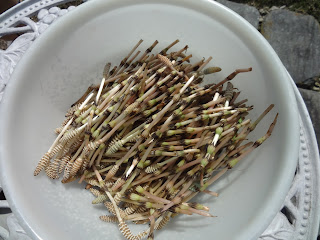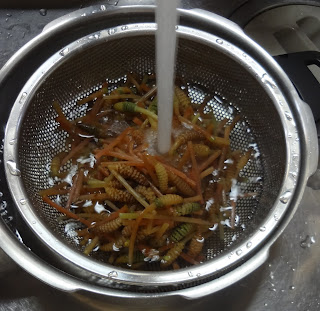Spring has come! There are lots of ways to enjoy warm weather in
Japan. One of them is welcoming spring wild herbs in kitchen. Er, well, we can
go to supermarket and buy some of these commercially grown from somewhere, with
price tags reflecting the food mileage. As you may know it already, they are
not cheap. When a head of cabbage is 200 yen ($2), 50g of wild herb could cost
more than 500 yen ($5) … If you know well wild edible plants of the area, AND
(which would be the most important) the landlord of the place, with the
permission of the property-owner we can gather wild herbs by ourselves. Unfortunately,
here in Japan the power of proprietor over land is strong, and normally it’s
difficult to have blessing from landlords to enjoy wild herb gathering …
My family lives in “rural” part of the city of Yokohama where there
still are lots of bamboo forests. Last spring, when my dad did his daily walking
exercise with his backpack for purse, his driver’s license and a water bottle,
a policeman stopped him to check his bag. He was astonished but obliged by
opening his almost empty knapsack. The police apologized to my dad “many many
times” (so he said) and explained why the officer had to do this. According to
him, thanks to a revival in appreciating “country life,” many people from the
downtown ventured into the field and forests of our neighborhood. (Our town is
in just a 15-minutes’ commuter train ride from Yokohama Station 横浜駅.) Downtown people didn’t know anything, and
without any permission of the owner of the land “collected tomato from a field
or dug bamboo shoots from the ground right next to landlord’s house.” Hence,
these 2 or 3 years when spring comes, the local police receive lots of 110
(which is 911 for the US) from the local farmers, reporting “burglary of bamboo
shoots” and “theft of cabbage.” Police rushed into a bamboo forest and “arrested”
thieves red-handed when they were smiling and staffing their bag with bamboo
shoots. The “criminals” were often dumbfounded and asked the authority “Huh? Is
it a crime?” So, in spring, the policemen of our neighborhood are busy in a
park asking people with a daypack to open their bag for inspection. Listening the
story of my dad’s experience, the Chairman of Niiharu Lovers’ Association 新治市民の森愛護会 who is
one of the landlords of Niiharu Citizen Forest 新治市民の森 said “Oh, yes, that’s very serious in Niiharu
as well. It’s a lamentable situation in Yokohama …” I thought my dad’s
conversation with a police was evidence how far we in city have been separated
from the nature of our neighborhood … City rats simply don’t know how to enjoy
spring bounty in a civilized manner. Recently, I’ve noticed another thing for not
many people knowing a very easy spring herb which I took for granted as
elementary. That’s Tsukushi of Equisetum arvense, or a reproductive
shoot of the field horsetail.
 |
| A
photo taken in a park near my home. The majority of plants here are wild and edible in spring. No Tsukushi here, though. |
Equisetum arvense is of fern family ubiquitous in Japan. It loves sunny wetlands but
can thrive in farm field. The plant rapidly spreads by rhizome and pore. For
agriculture, it’s simply a weed to be removed. We can find it at edges of
commercial ag-land, or in the suburb of Tokyo such as Yokohama, in front yards
of large condo or detached houses. For adults, it’s extremely stubborn nuisance
for garden. Though, I have a warm memory of its reproductive shoot, Tsukushi in Japanese. When I was three
or four years old, my mom taught me it was edible. The plant has a very
distinctive and cute shape easy to be recognized even by kindergarten kids. “It’s
cute and mom said we can eat it. There are many, and no one cares!” So, we
neighborhood kids ventured in sunny suburban roads and gathered them. Lots of
them. Adults did not like the weed to thrive so we often had praise. “Oh, good
girls! Thank you for cleaning up my garden / cabbage et al patch!” These days,
kids in Yokohama are busy in programmed after-school activities or video games.
But Tsukushi come out in the same
place as decades ago. Their status as weeds for commercial agriculture or
gardening has not been changed. Unless we enter deeply into a private property,
picking Tsukushi does not raise eye
brows much, let alone (yet) calling the police. To enjoy spring herb easily, it
offers us the best (and cheapest) option!
 |
| Tsukushi. Cute. |
One sunny recent weekend, I took a walk to my childhood territory
that was still farm lands. Yeah, Yokohama is a good place to live … skyscrapers
and idyllic countryside co-habit … Yeah, as before, cute Tsukushi came out freely, and no one cared. I gathered them for
about half an hour until my small plastic bag became full. Many strollers saw
me doing the thing, and wondered what I was up to. “Why does she pick them?”
“Dunno …” “Oh, I’ve heard we can eat them!” “But how?” Listening their
conversations in my back, I realized people have forgotten about Tsukushi … But we kindergarten kids did
the same and our moms cooked them for supper. Where have all the memories gone?
 |
| Lots of Tsukushi! |
For one thing, although Tsukushi
is edible, the plant contains thiaminase, alkaloid, and silicon so that
consumption of lots of it is not at all recommended as it can cause deficiency
for vitamin B1. For patients of heart or kidney disease, or people allergic to
nicotine, eating Tsukushi is contraindicated. For another, preparation for
cooking is cumbersome with Tsukushi.
I suspect the latter is the dominant reason why city people forgot eating abundant
Tsukushi in spring. But if you don’t
mind quiet preparation of Tsukushi, it’s
a fun even with a broken wrist like mine. Here is how I did it this time.
 |
| My harvest |
First, we must know the brown “leaves” wrapping the stem are not
edible. We have to remove them. We can peel the leaves of course, but much
easier way is to cut the bottom of a leaf …
 |
| Leaves of Tsukushi |
 |
| You can peal a leaf like this, or |
 |
| Cut the bottom of a leaf. |
 |
| A leaf slips out like this. |
Continue “cut-and-slip” to remove all the leaves. If you are not
strong with bitter veggies like chicory or radicchio, cut off the ear as well.
I personally think the best part of dishes with Tuskushi is in the bitterness from the ear, but it’s really a
matter of choice.
 |
| All the leaves are removed. |
Dunk the processed Tsukushi
in water preferably as you continue working with the rest for removing the
leaves. Though, it’s OK you rinse all the processed Tsukushi at once. Wash them until there is no trace of grits at the
bottom of a bowl. Next, leave them for a while (about 10 minutes) under running
water. It is to get rid of the tartness from Tsukushi.
 |
| Wash-and-soak stage |
Next, drain Tsukushi. Some
recipe (for example, here or here) suggests to cook Tsukushi at this stage. But they can taste still harsh, and might
be for an acquired taste. To cook them I recommend you to boil them next. You
can simply boil them, or add a bit of salt as you cook pasta. I took pasta-way
this year. You first dump them in a plenty of boiling water, and wait. When the
pan returns boiling, drain Tsukushi
quickly. Don’t overcook. A bit of crunchiness is a charm of dishes with Tsukushi.
 |
| Boiling Tsukushi |
 |
| I
washed the boiled Tsukushi after draining the water, to stop over-cooking and to remove the bitterness further. |
Now we can sauté them, or eat them as condiments for salad. (Sans
ear) Tsukushi omelet was in a spring
menu of our family when we were in kindergarten. You can keep it as is in
refrig for several days.
 |
| Prepared
Tsukushi. After draining the water, I squeezed Tsukushi a bit. Don’t over-squeeze! Don’t’ crush them! |
This year, I cooked Tsukudani
佃煮 with Tsukushi. The recipe is simple. For 140g
of prepared Tukushi as above, add 2
tbsp of soy source, and 1 tbsp of sake, mirin, and sugar. Cook it until the
liquid almost evaporates, and let the pan cool completely. We can keep it in
refrig for about a month. It’s tasty spring tapas accompanying for good
Japanese sake … Though, in our household, it lasted for only 3 days. Cheers!
 |
| My Tsukushi Tsukudani |
<Bonus info>
Recently, I’ve found an easy way to concoct skin tonner. In Japan,
we have many kinds of citrus with which often contain lots of large seeds.
Carefully remove the seeds when you eat a fruit (don’t lick them!), and gather
them in a jar. Next, pour white liquor 10 times of the volume of seeds. Leave
the jar for at least 7 days in a dark place, and Voila! Citrus skin tonner is ready for your daily skin care. It’s
cheap and we can use it as much as we want. By applying it continuously, I’ve
noticed my skin becomes smooth and soft. Though, I haven’t made it with sweet
citrus like orange as I think they contain too much sugar. In contrast, lemon
seeds have become a good lotion. Try it!
 |
| My
citrus skin toner. The finished product has a bit of consistency but smooth when you apply it to your skin. |


No comments:
Post a Comment